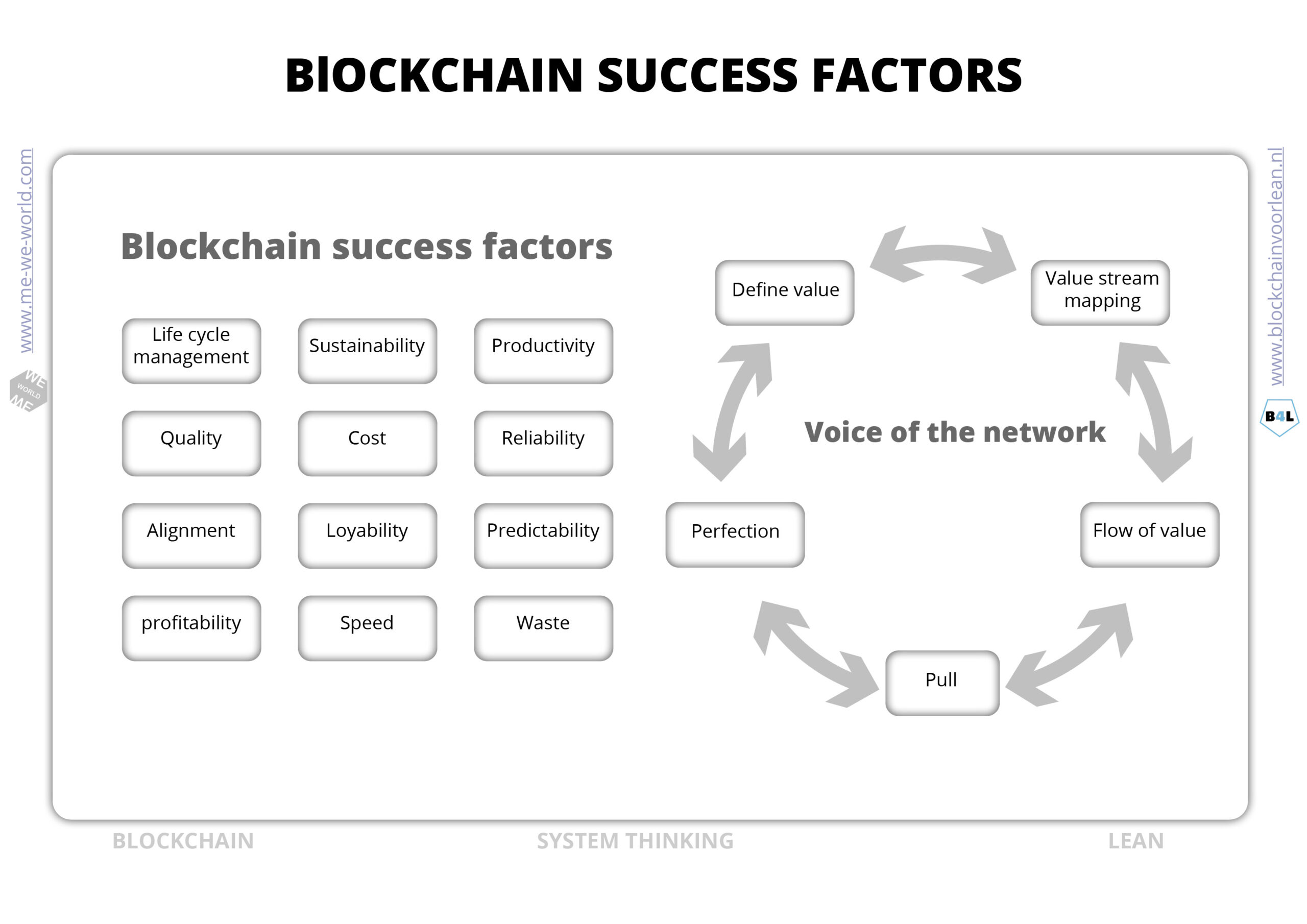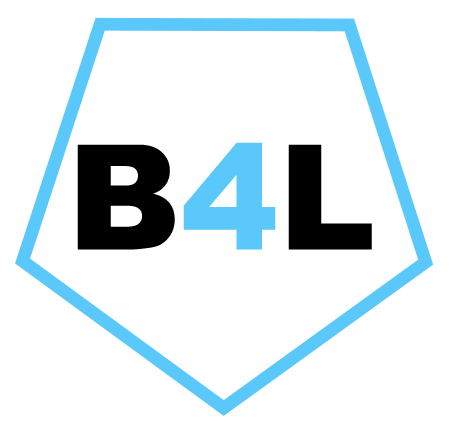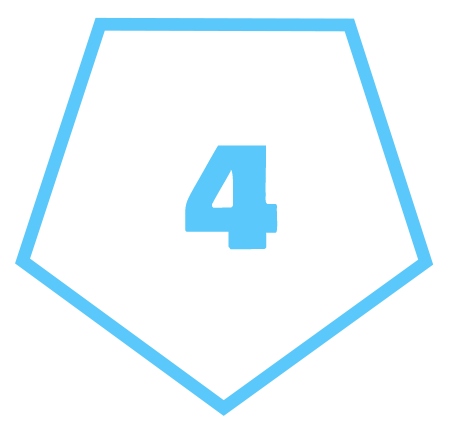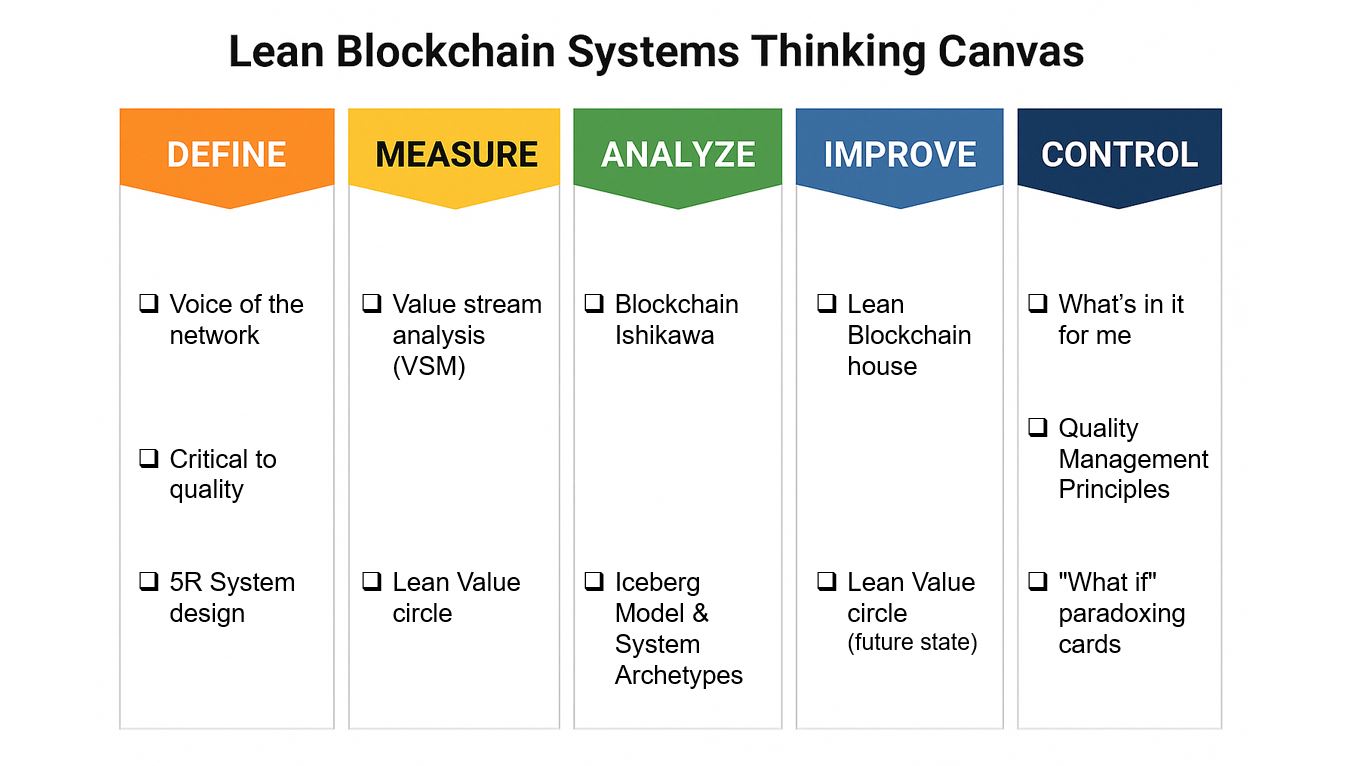
This diagram applies the DMAIC cycle (Define, Measure, Analyze, Improve, Control) to Lean Blockchain System Thinking.
In the Define phase, systemic problems are identified, quality requirements are established, and the 5R system design is used to understand processes.
In Measure, the current value stream is analyzed (Value Stream Mapping), and the Lean Value Circle is used to visualize inefficiencies.
In Analyze, a Blockchain Ishikawa diagram (root cause analysis) and models like the Iceberg Model and system archetypes are used to uncover deeper causes.
Improve focuses on designing improvements through the Lean Blockchain House and creating a future Lean Value Circle.
In Control, improvements are sustained by focusing on ‘What’s in it for me’ (motivation), quality management principles, and ‘what if’ paradox cards.
This DMAIC approach combines lean thinking with blockchain structures to build efficient, robust systems.
Lean Blockchain house
What are the 5 key elements that blockchain adds to the lean house?
1. Alignment of Purpose
Processes are a derivative of an organizational strategy and determine the common goals and shared values. It gives “purpose” to the organization and enables alignment with people and processes. BC enables this for business collaborations.
2. Build in trust
BC has solved the double spending problem on the internet. Processes can be redesigned without the need of a (non value adding) trusted third party in the middle.
3. Value Stream
How do you get flow in processes if the value flow is continuously interrupted by an intermediary? BC allows value to pass from hand to hand. Transparency and visual management provides insight and control by design for all participants.
4. Quality and time
Blockchain shares information from the source/expert/oracle. This method not only saves a lot of time (just-in-time) and costs (first-time-right), but also ensures that the input quality comes from the expert.
5. Culture
What if we could design an infrastructure that contributes to the 17 Sustainable Development Goals? We now have the tools (BC, IoT, AI) and knowledge (lean thinking).
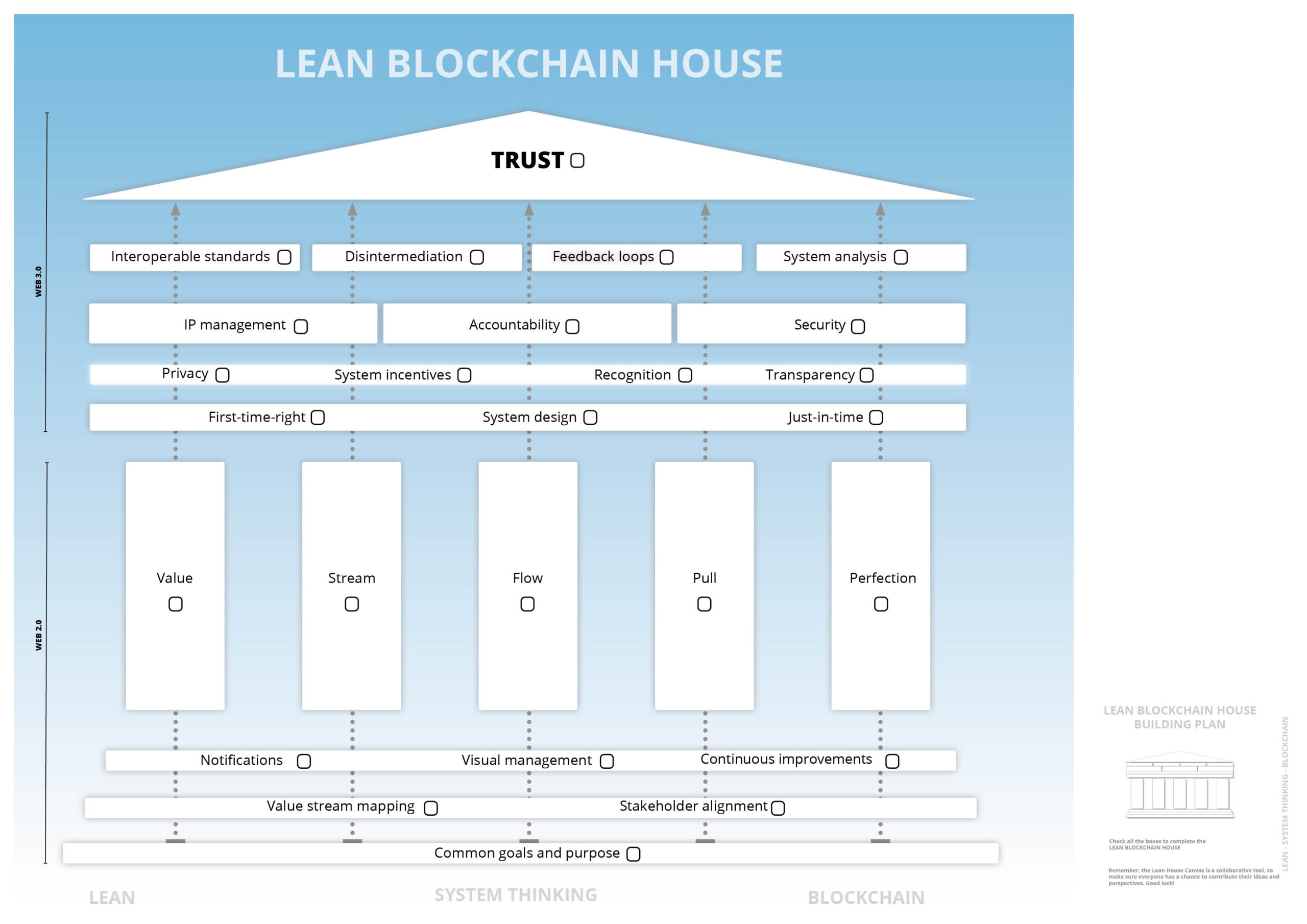
Value stream mapping – reinventing value flows
Value stream mapping
Provides a visual representation of the value and non value adding activities. It is used to optimise and understand a process.
- Value adding (VA)
Activities the customer is willing to pay for. - Non value added (NVA-W), waste
Peer-to-peer transactions eliminate numerous constraints in the flow of value, such as waiting times, overproduction, overprocessing, defects, and the need for intermediaries. By removing these non-value adding activities, blockchain streamlines the value exchange process, making it more efficient and seamless. - Non value added (NVA-R), requirements.
Smart contracts revolutionize collaborations by enhancing their efficiency, effectiveness, and predictability. These intelligent contracts establish the new rules of the game, providing a reliable and automated framework for conducting business transactions. With smart contracts, parties involved in a transaction can trust that the agreed-upon terms will be executed accurately and without the need for intermediaries.

Just-in-Time
Just in time means delivering exactly what the customer needs; the right product, in the right quantity, at the right time. The aim of the methodology is to optimize coordination between the logistics of stakeholders and create maximum flow and minimize internal stock. Blockchain will integrate process and product information within and across enterprise boundaries. What ERP (Enterprise resource planning) did for a single company blockchain will do for networks of companies.
System thinking
With design thinking the goal is to think in a cooperative system to overcome traditional bottlenecks in value flow. Lean consultants already know that transparency, standardization and real-time information are very powerful tools to reduce variability and instability in a system. With blockchain these tools are integrated in the concept. An additional benefit is that measurement, analysis and improvements are made from a common interest and shared point of view.
Stakeholders who normally don’t work that close together do now have an incentive to contribute to a just-in-time the system.
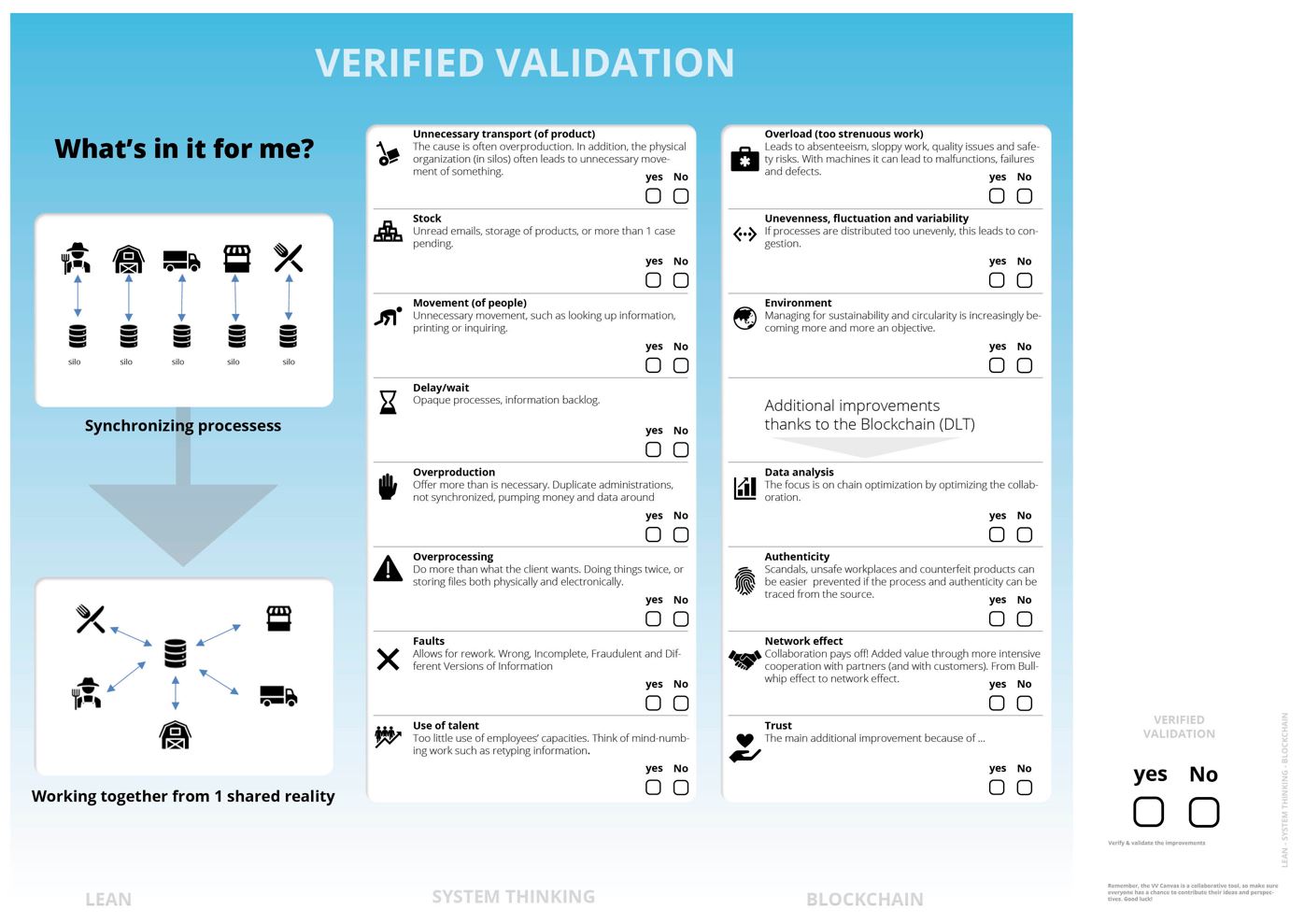
Quality management
How does Blockchain improve quality management?
Product
Blockchain brings transparency to the input quality. It makes it possible to verify and prove authenticity based on Smart data. It is even possible to tokenize real assets by creating a digital twin and track and trace the unique item throughout the entire supply chain. Also documents, qualifications, licenses, certificates can be digitized.
Organizational
The purpose (Hoshin Kanri) of a blockchain is based on a shared understanding (standards) and reality (visualization). A lot of waste is avoided by the re-use of data from the source (waste/trust management). With signals (kanban) and direct feedbackloops (alignments) it looks like a supermarket model (Taiichi Ohno).
Business
With blockchain the Who, When, What becomes clear for the entire process. It brings consensus to the needs, the expectations and critical activities of all participants. The end-consumer is often part of the solutions. This makes it easier to measure and monitor satisfaction and take appropriate actions to improve the functioning of the entire chain.
Total Output Quality
By collecting information about the possible environmental, social and economical costs and benefits or advantages environmental full cost accounting becomes reality.
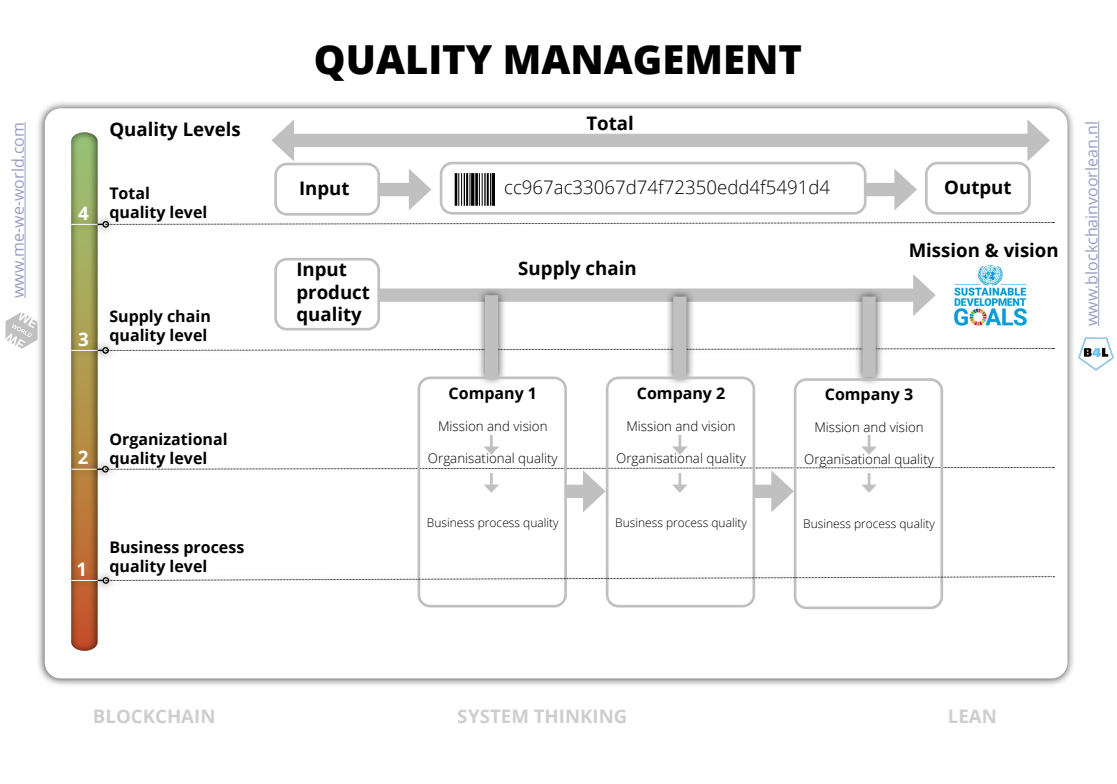
Reduce the non value adding activities
A system comprises value-adding, non-value-adding, and essential activities (like KYC procedures). Lean focuses on maximizing value-adding activities, while Blockchain minimizes waste by design. Systems thinking ensures we prioritize what truly matters!
3 principles to reduce the waste by design:
1. Lean thinking: peer 2 peer value exchange
2. Blockchain thinking: automated system rules with smart contracts
3. System thinking, continuous improvement and analysis of the whole
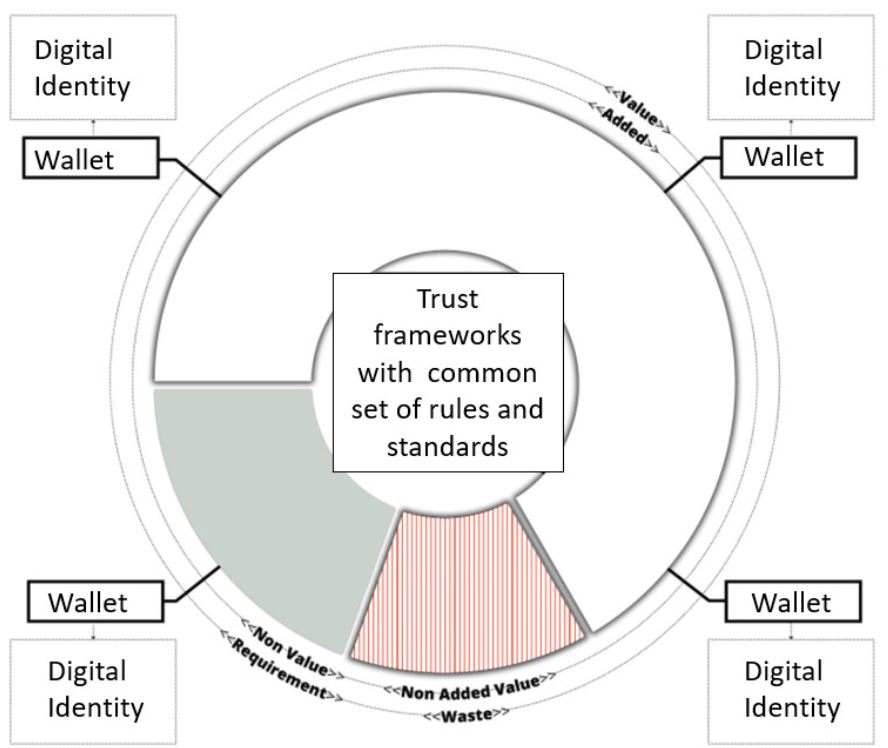
Roles, Resources, Rules, Relationships and Results
Roles/Identity
Unique identifiers for people (SSI), companies (wallets), for content (CID) and products (DID’s). DID’s rely on cryptography to prove that you are in control of a given identity.
Relationships
Digital data carriers on physical products (like a QR code, RFC) with look-up mechanism. Legal identity identifier (LEI).
Rules
Data processing, data exchange, storage, authentification, integrity, security and privacy protocols
Resources
Intellectual property, verifiable credentials, linked Data links information to a precise uniform Resource identifier (URI). Similar as URL points to a specific website, a computer can automatically understand the information received from a URI.
Results
Digital identities (DID), verifiable credentials (VP), verifiable presentations (VP) and Linked data are powerful examples of standardization. These are the Lean building blocks systems should be designed.

Evolution of accounting
In daily live we do a lot of transactions. In fact, you could think of any interaction as a transaction. However, we only record valuable transactions by writing them down in ledgers/ databases/registers. Those ledgers allow people to demonstrate his or her property or achievements to gain value in a social context. Basically they coordinate ownership, identity, the status and authorizations.
Central coordination: proof by authority
So everything that has value is nowadays stored in ledgers. Those ledgers are the starting point for all transactions of value. Organizations that provide storage and access to the data are called intermediaries or third parties. Intermediaries exist because we don’t trust each other. Intermediaries therefore organize trust and play a pivotal role in this. And the customer pays for this service.
Trust in cryptography
Blockchain technology solved the “double spending problem” on the internet. For the first time in history peer-to-peer transactions can be executed without the need of an intermediary or third party.
The technology is often called “digital ledger technology”. By timestamping balances and providing access to those balances it can (partly) replace the work of the intermediary.
Suppose we no longer use an intermediary for transactions of value on the internet? What will happen to the processing time, the quality and the cost of those transactions? And of course the customer value?
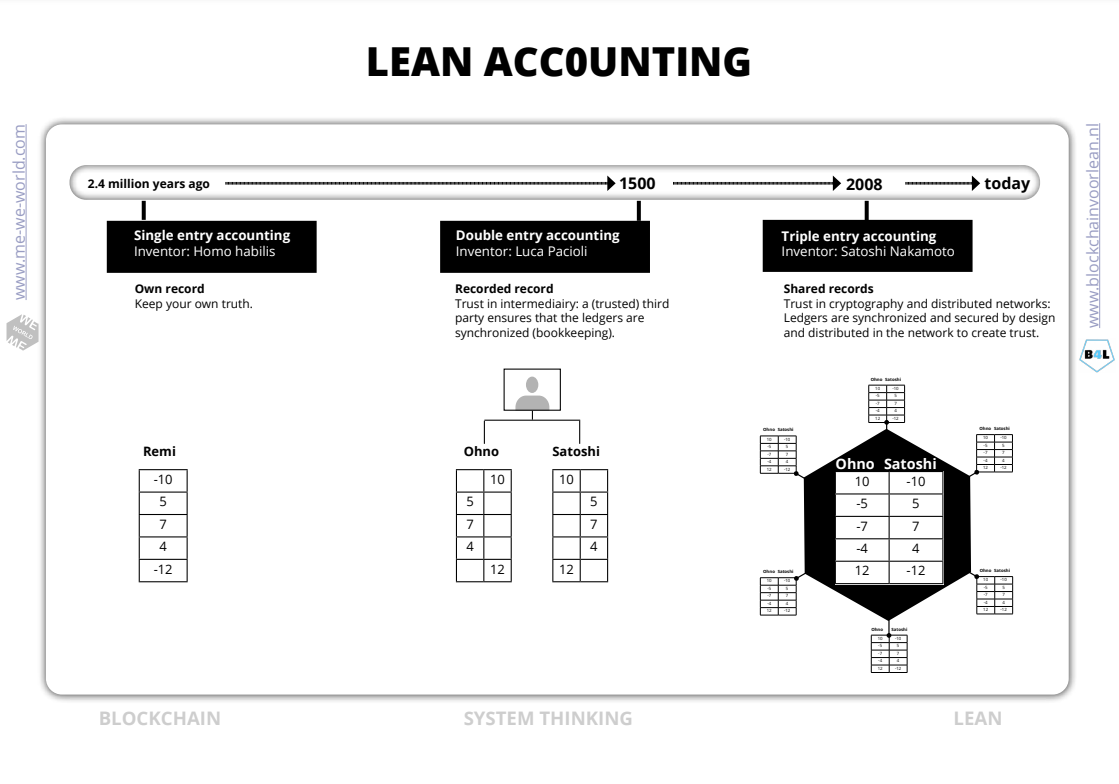
Business process innovation
In processes the material flow (what is needed for production) is often decoupled from the information flow (information what needs to be done) and payment flow. Decoupling of flows causes waste in operation, such as unnecessary stock, loss of quality, waiting, over processing and so on. Synchronizing these 3 value flows is called “settlement”.
By digitizing the product, payment and information flow these flows can transact simultaneously in an one piece flow (transaction). The goal is to reduce settlement time to zero.
Note that the decoupling or fragmentation of information (value flows) leads to further coordination issues, like waiting, emailing, inquiry, research, control, overproduction, trust issues etc.
With linked, digitized and tokenized (atributes/passports) of data, settlement can be synchronized and available 24/7. By optimizing the transfer of value flows and thinking in systems a lot of waste is avoided.
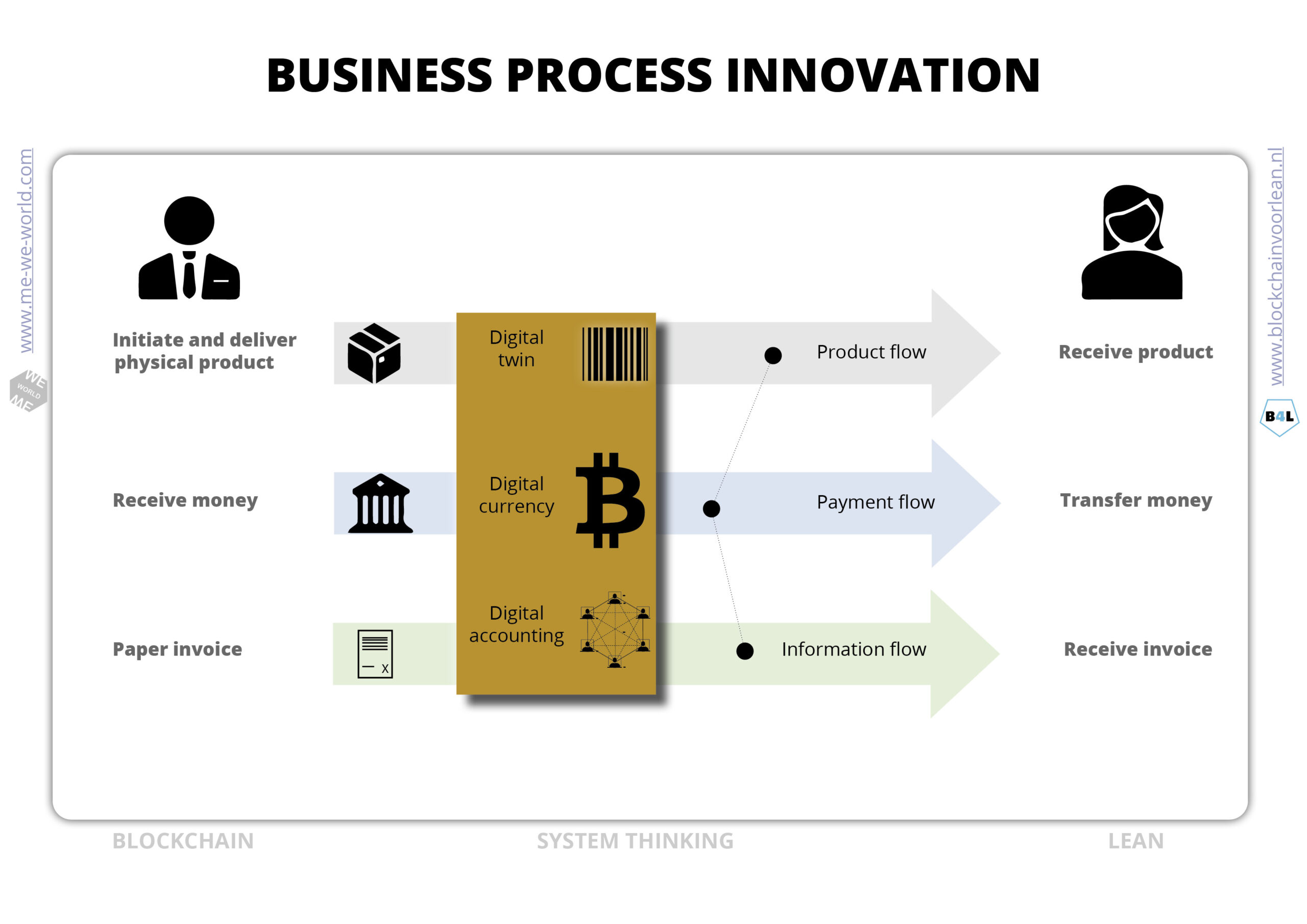
Kanban innovation: stock and flow
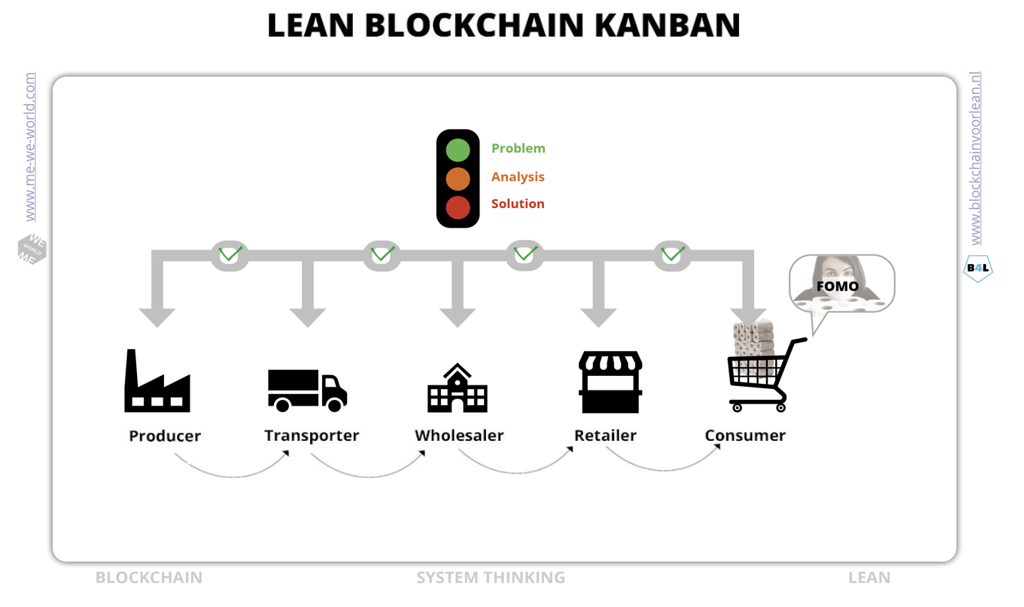
What is Kanban?
Kanban is a way to make work in progress visible. By tracking, tracing and visualizing the stock (the in- and outflow) the end 2 end process becomes more predictable. The goal of the method is to give feedback in response to an action. It helps to identify and resolve potential bottlenecks in the process, so that the work can be done right the first time (first-time-right) with optimal speed or throughput (just-in-time).
How does it work?
Kanban (from the Japanese ‘kan’, meaning ‘visual’, and ‘ban’, meaning ‘card or board’) signals when something needs to be done.
Two Bin Kanban
Taiichi Ohno, 1960 The first Kanban system was developed by #Taiichi Ohno (industrial engineer and businessman) for Toyota in Japan.
Digital System Kanban
Satoshi Nakamoto, 2009 On January 9, 2009, Nakamoto released open source software that allows you to share status updates with pseudonymous actors that you don’t have to rely on.
Kanban Innovation
The technology behind this new invention, better known as Blockchain, lends itself well as a collaboration technology to make processes more efficient and effective.
What is a NF Tree?
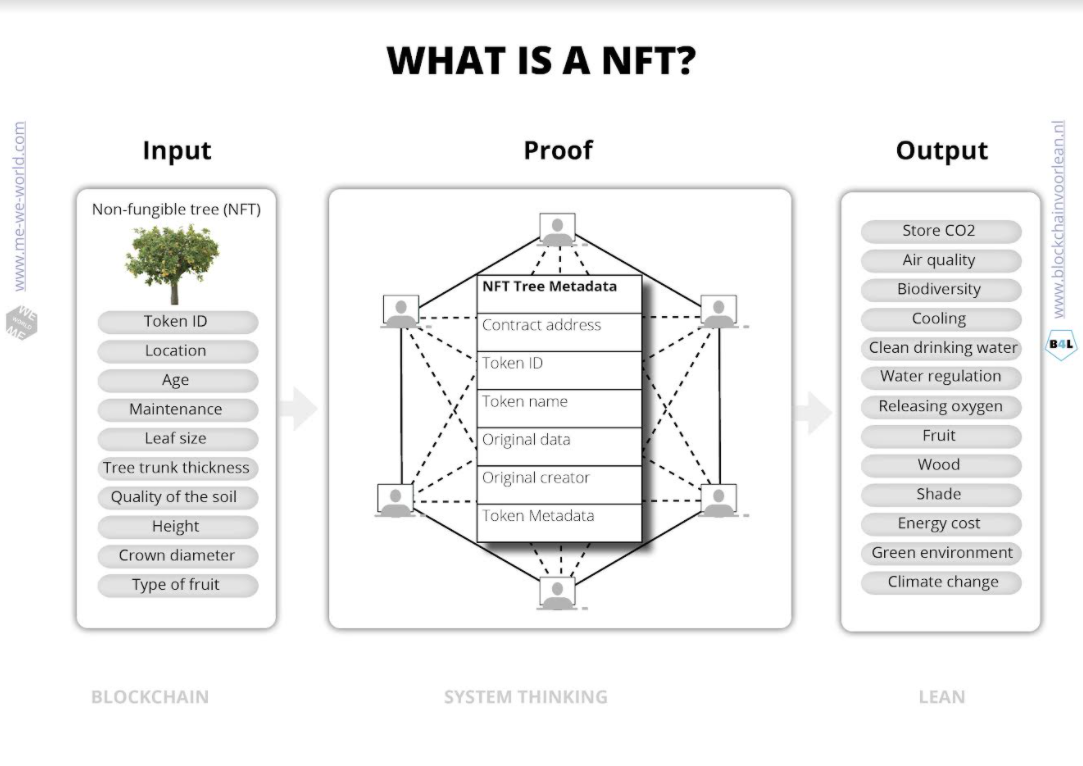
Lean thinking – Lean system thinking
How do you create alignment with focus on quality management?
- Customer focus
- Network governance/collaboration
- Incentives/alignment for value adding activities
- End-to-end process approach
- Network improvements,
- Feedbackloops
- Evidence-based desicion making
- Agility, system thinking, respond to change
With Lean a status overview is often used to provide insight of information, like who, what and when things where done. Blockchain provides in a transactional and status overview to do this for end-to-end processes. The status is updated when a transaction takes place in the network and it gives certainty of ownership and execution with the approval of all stakeholders. We now have a collaboration (lego) toolset to improve the quality, reliability, flexibility, cost and throughput of interactions between businesses. Thanks to the direct feedback loops from all the coalition partners/stakeholders, the system can be continuously improved.
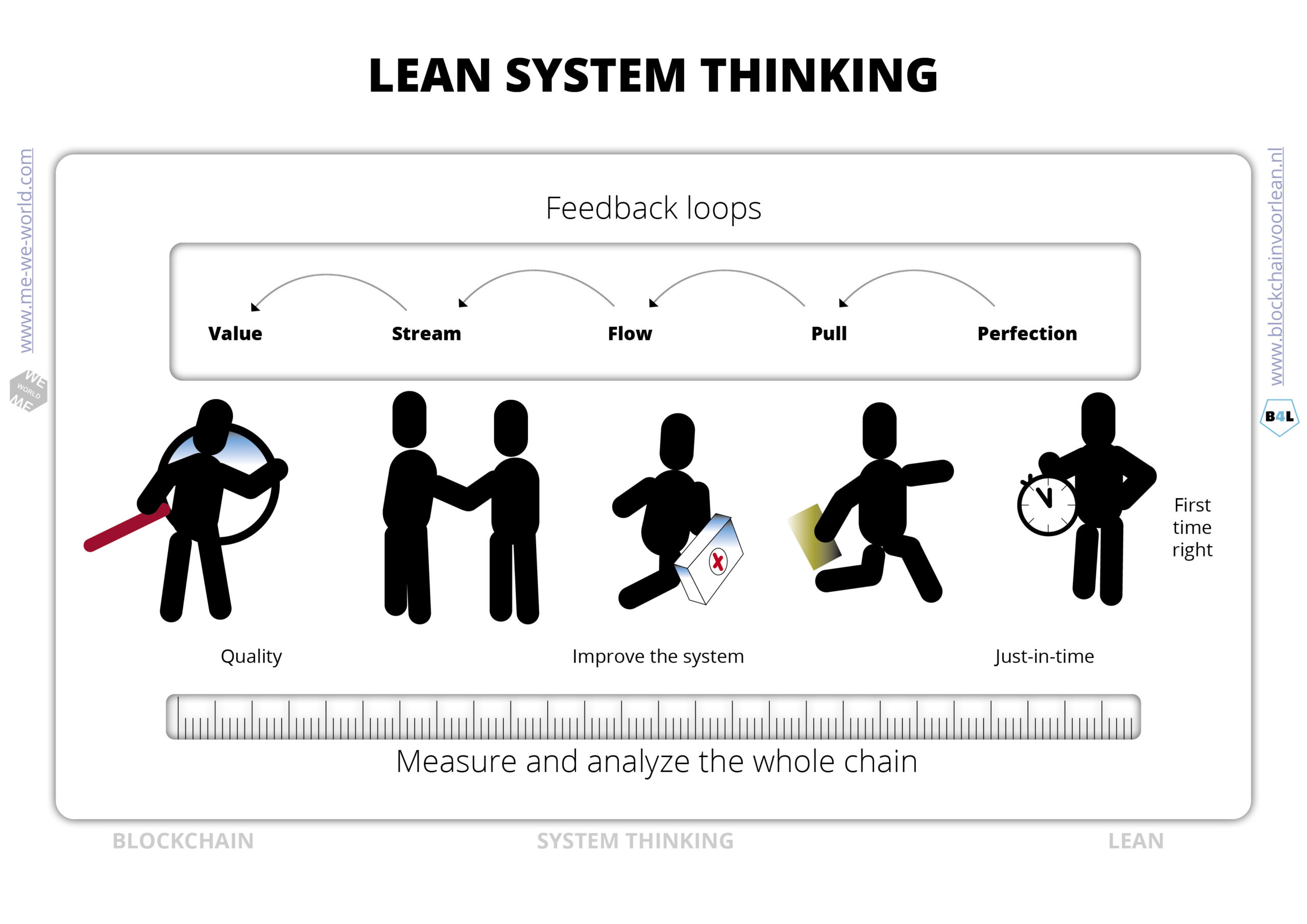
Lean Blockchain principles
The power of a blockchain is to solve multiple problems at the same time with a shared mission and vision. The economic functioning of a blockchain system is called tokenomics. It describes the governance, incentives and economic design. It focusses on the behavior and interactions of participants in the system.
Important to analyze and clarify:
• arrangements
• expectations
• roles
• contributions
• incentives
• assumptions.
Blockchain for lean is a business strategy based on lean thinking, lean system thinking and improving flow with better alignment, collaboration, incentives and co-creation. Be part of the lean-blockchain coalition and find the others!
A Voice of the network analysis helps to determine the interests and goals of each participant of the network. It gives directions how to find common ground, shared interests and fair incentives to contribute to shared goals. This is important because different stakeholders have different needs, purposes and goals. “Meeting customer expectations” and designing contributions and incentives to shared goal, are the main drivers for a successful Lean or blockchain project.
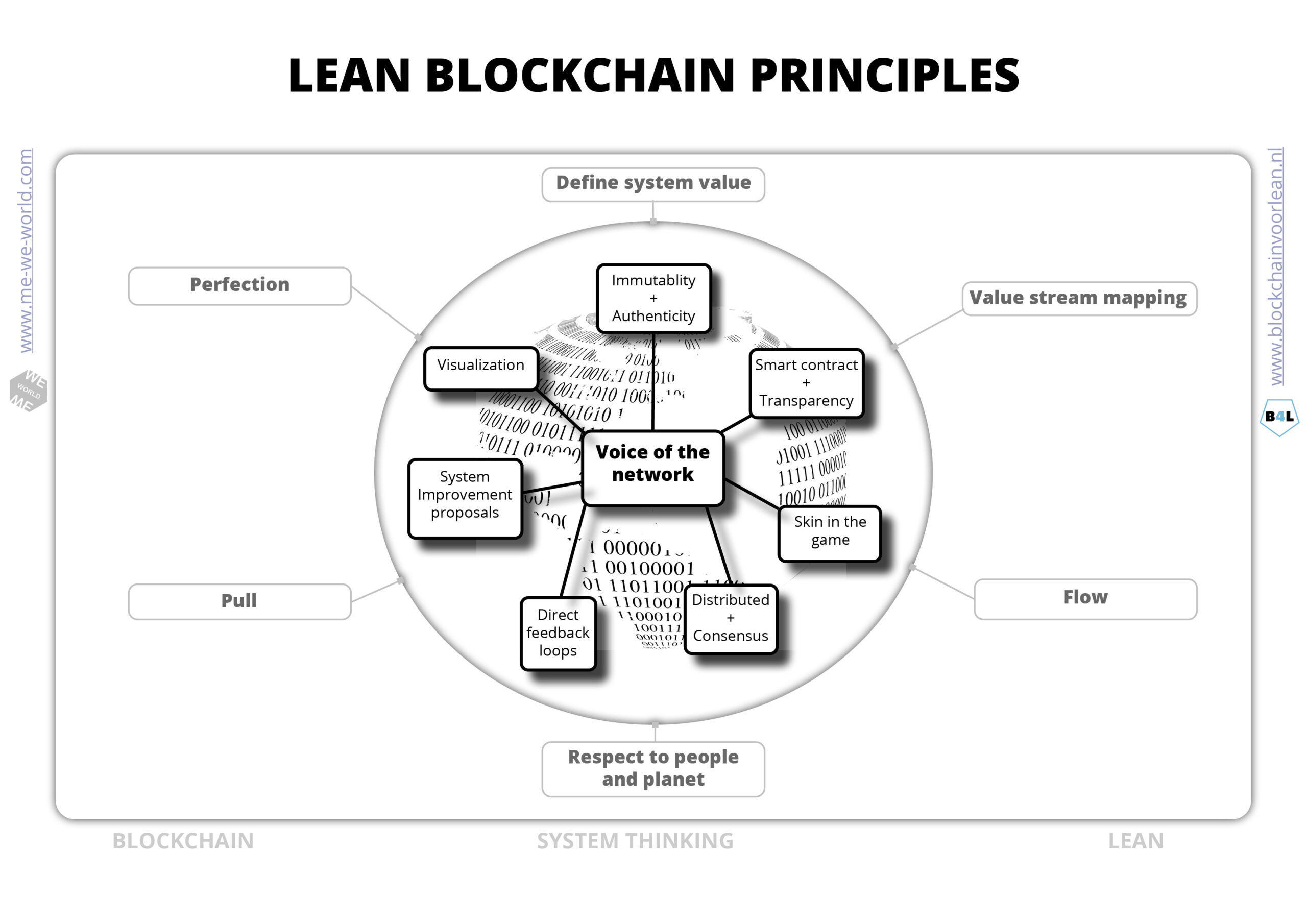
Procedures (SOP) automated
Human collaboration is underpinned by relations, contracts and procedures. A standard operating procedure (SOP) is a written work instruction that describes in detail how a certain action should be performed. Blockchain and smart contracts in combination with “oracles” brings new ways of executing contracts and procedures on the internet. They differ in the way they execute digital agreements (automated and distributed) and also the way data is recorded and stored is different. Data flows from the source, becomes immutable (delete button is missing) and actions are done with consensus beforehand.
Performance data will trigger the contract. The data can be generated online or offline. Validation and verification of the data is an important part of the system design: garbage in = garbage out.
Anyone can agree on a binding agreement on the internet. The smart contract offers participants a guarantee that the contract will indeed be fulfilled when an event occurs.
A participant does not have to trust any another participant. The contract will be executed when an event has taken place. Trust is integrated in the system (code). This makes end-to-end processes more reliable and predictable.
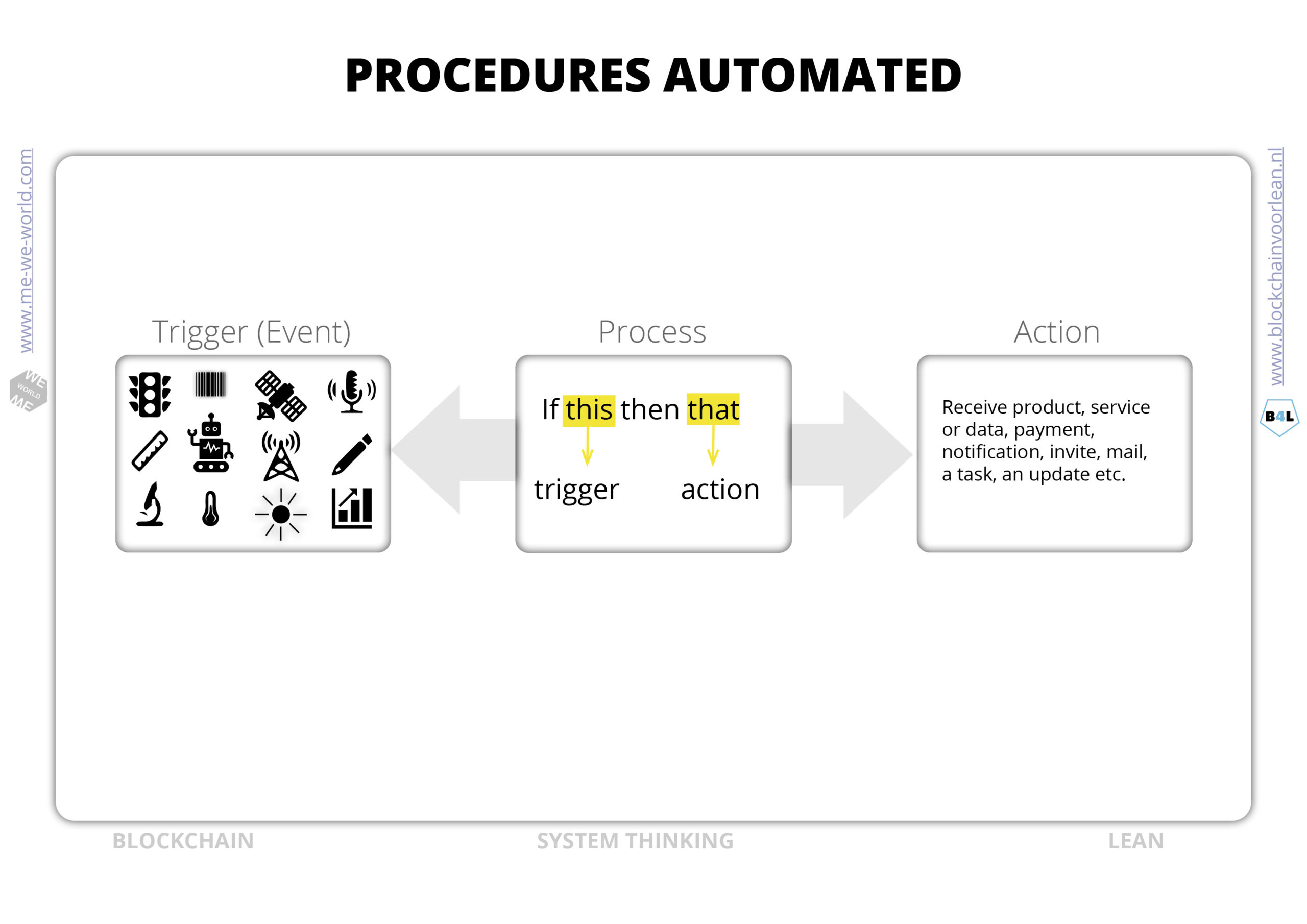
Start with why?
If you have any doubts on the potential of blockchain, then ask yourself the following questions:
- Why do we all keep our own records? While we know that this is one of the biggest bottlenecks for value flow.
- How do intermediaries contribute to value flows? With limited opening hours and centralized power.
- What problems can be solved with adding more transparency?
- What makes it so hard to settle process, product and payment flows?
- How can we ensure sustainable cooperation, better coordination and communication?
The internet changed the way information flows. Today, we’re implementing and redesigning the way value flows.
For a big part blockchain technology is about redefining processes and forming the coalition of the willing. For this it is important that changemanagers inform and inspire people with the new possibilities.
Lean thinking and lean system thinking is the basis. The biggest challenge isn’t the technology, it is changemanagement from a more hollistic/system approach!
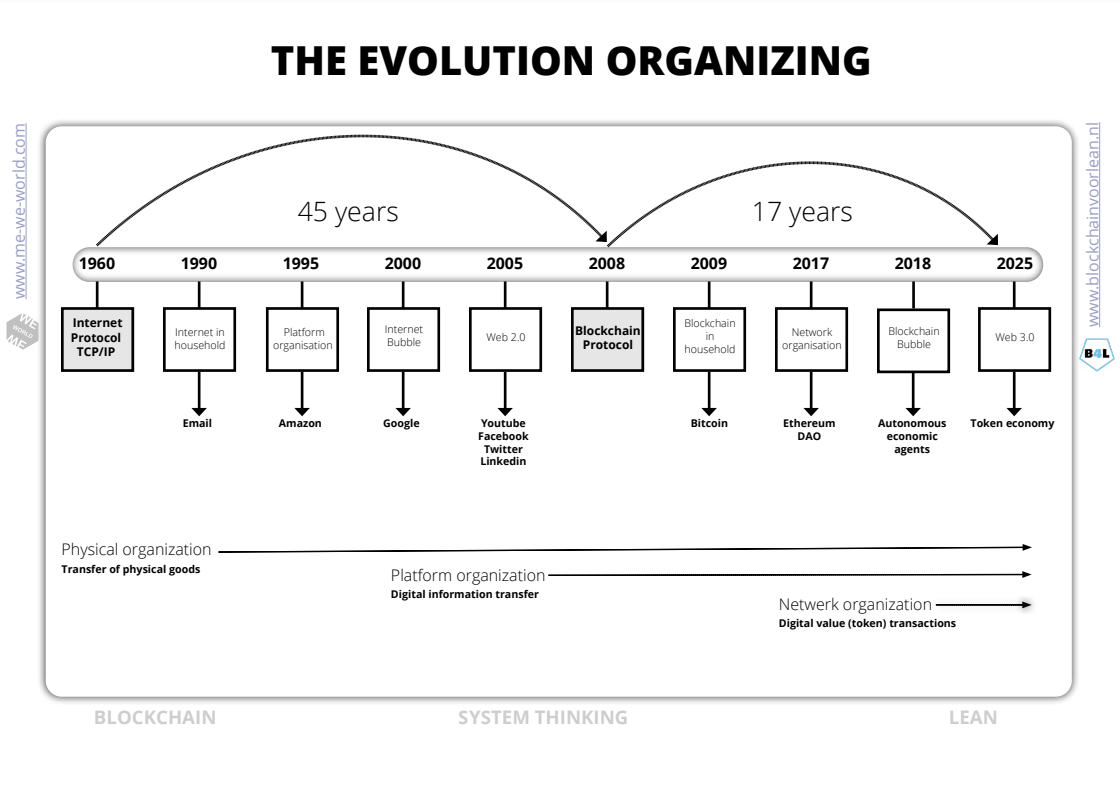
House of Value
Every process has a specific purpose. The goal of the process determines what is of value to the customer. Values can be translated into concrete standards with concrete taxonomy and regulations, but also in more intangible aspects like customer satisfaction or desired behavior. With blockchain and smart contracts it becomes possible to reward people for desired behavior, reach consensus and contribute to the purpose of the community. So what is value?
Tangible assets
Tangible assets are assets with monetary value in a physical form. It is worth a specific amount of monetary value and can be traded.
Intangible assets
Blockchain technology is a time stamping tool which makes it possible to register every interaction on the internet. Also intangible assets can be registered and rewarded. Think of liking or sharing content, reading or editing articles, or receiving a package for the neighbor. But also a company’s reputation, copyrights, trademarks, brand recognition can be digitized and transferred. This makes blockchain a new incentive mechanism for motivating people to do certain tasks.
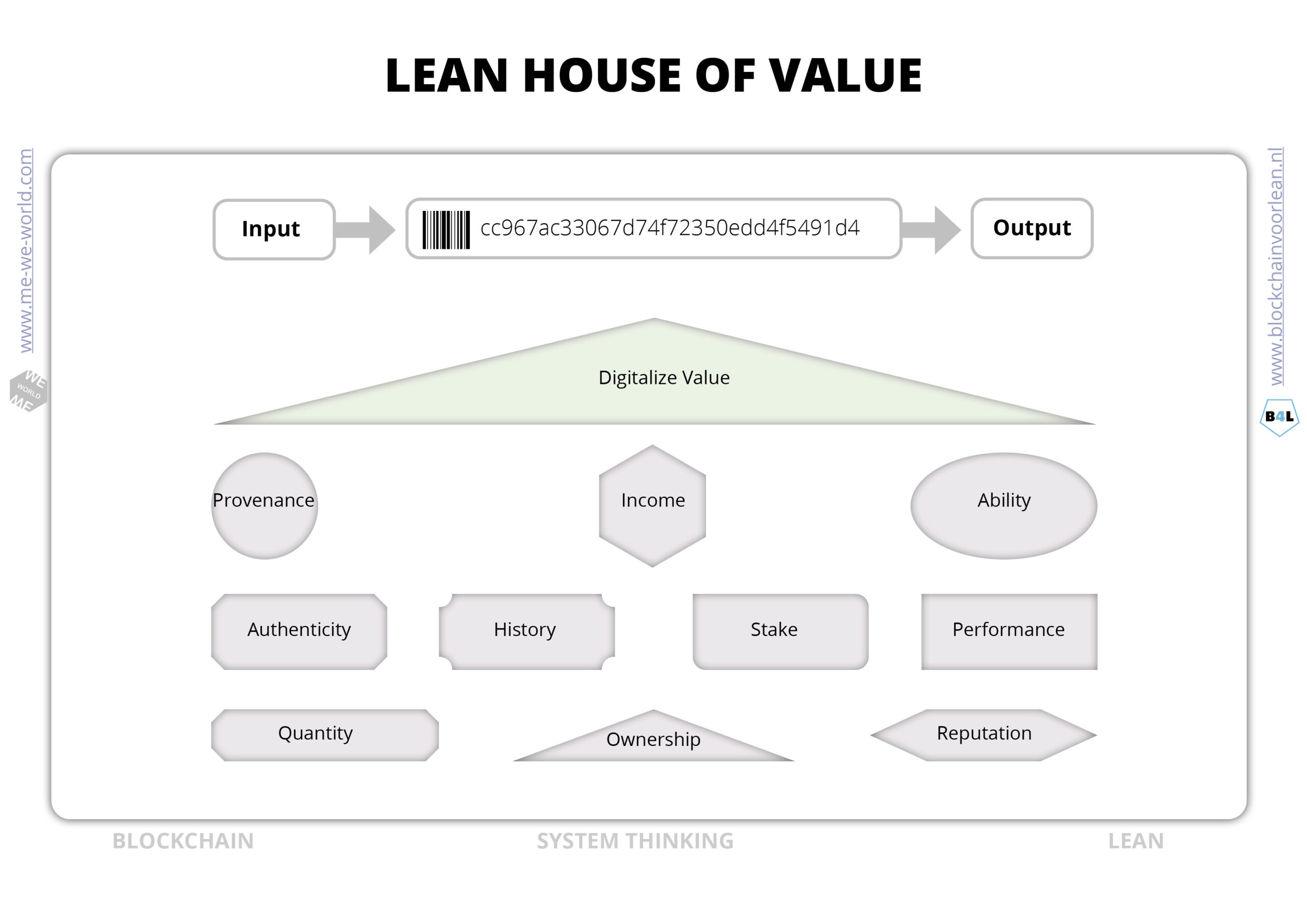
Do need a Blockchain?
There are various decision trees to determine whether blockchain is a good idea. If 4 of the 5 of the decision rules below can be answered with ‘yes’, there is a good change blockchain will have added value.
- Lack of trust. Suppose you don’t depend on a third party to find out that something is true.
- Lack of alignment and collaboration. Are you working with businesses that you don’t trust and with different interest and goals?
- Temper proof. Do you want to be dependent on someone you cannot trust.
- Automatic execution. Is the verifiable execution of processes (business logic) important
- Lack of flow. Will the throughput/lead time improve by sharing (re -use) information from the source? Will it prevent from waste? Like e-mail?
For business to consumer processes we find it quite normal that we have a track and trace system to follow transactions (the status) of an order. How is this completely different for tracking an tracing an status through a business to business network! Or for solving a worldwide Covid19 crisis. You can’t solve these big problems inside your business walls or inside your country borders.. We are interconnected. The world has a coordination, cooperation and communication problem! We need to collaborate, set a shared mission and vision and be transparant over the goals to be achieved.
Even a good person can’t beat a bad organized system. Let’s reinvent who value should flow!
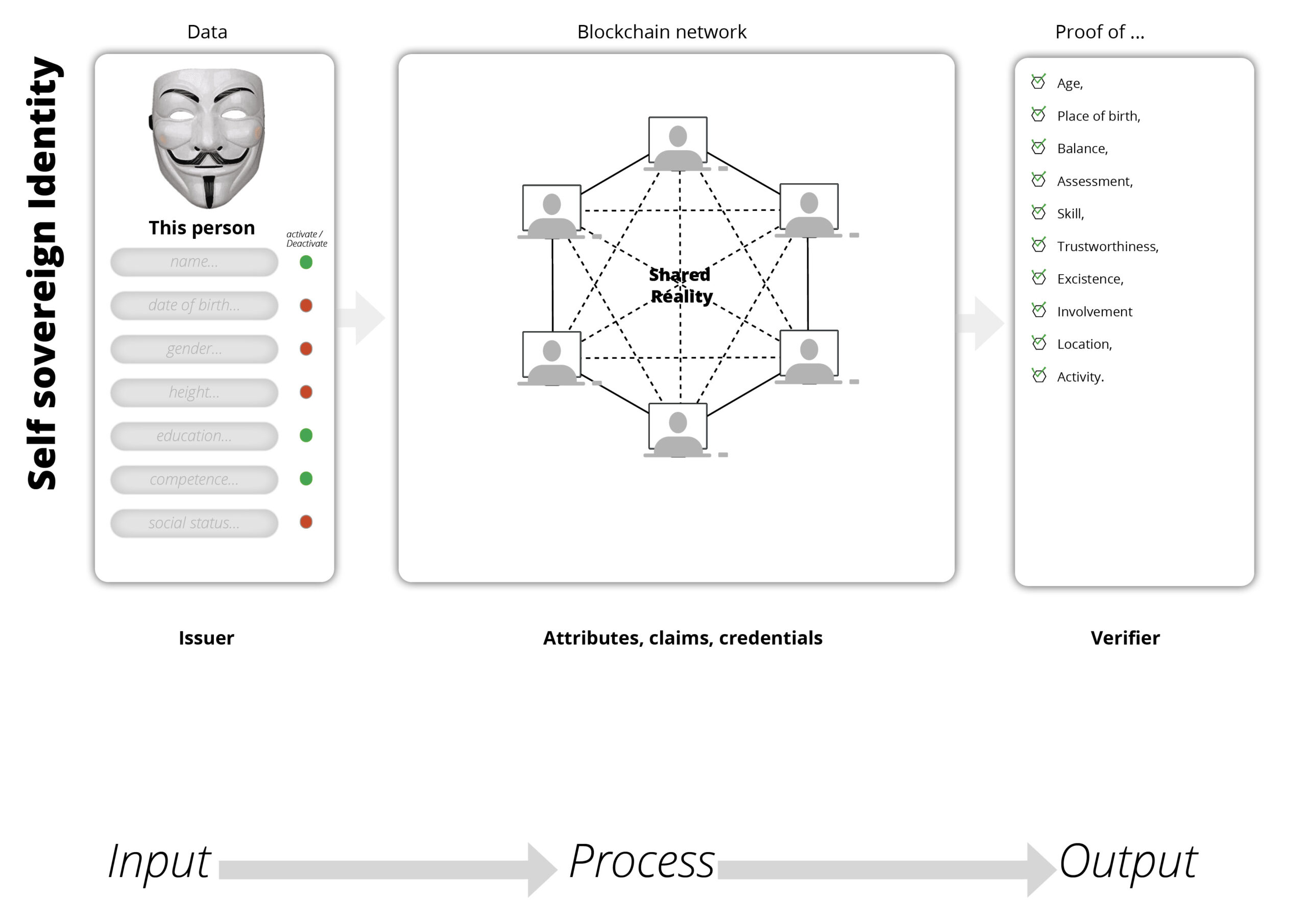
Ishikawa – a lean conversation starter
The Ishikawa diagram is a tool intended to map possible root causes of problems. Can it also provide insight into the main benefits of a blockchain solution? Why is lean system thinking helpful?
As Einstein puts it beautifully: “we cannot solve our problems with the same thinking we used when we created them.
Start thinking of optimizing end-to-end processes. Then businesses have to collaborate on common goals, assure alignment and be able to trust each other.
The concept of a blockchain can be used as a “Lean conversation starter” for creating insight, cohesion and shared understanding. With the help of a Ishikawa diagram in combination with a lean blockchain validator we can “proof” the benefits for each stakeholder.
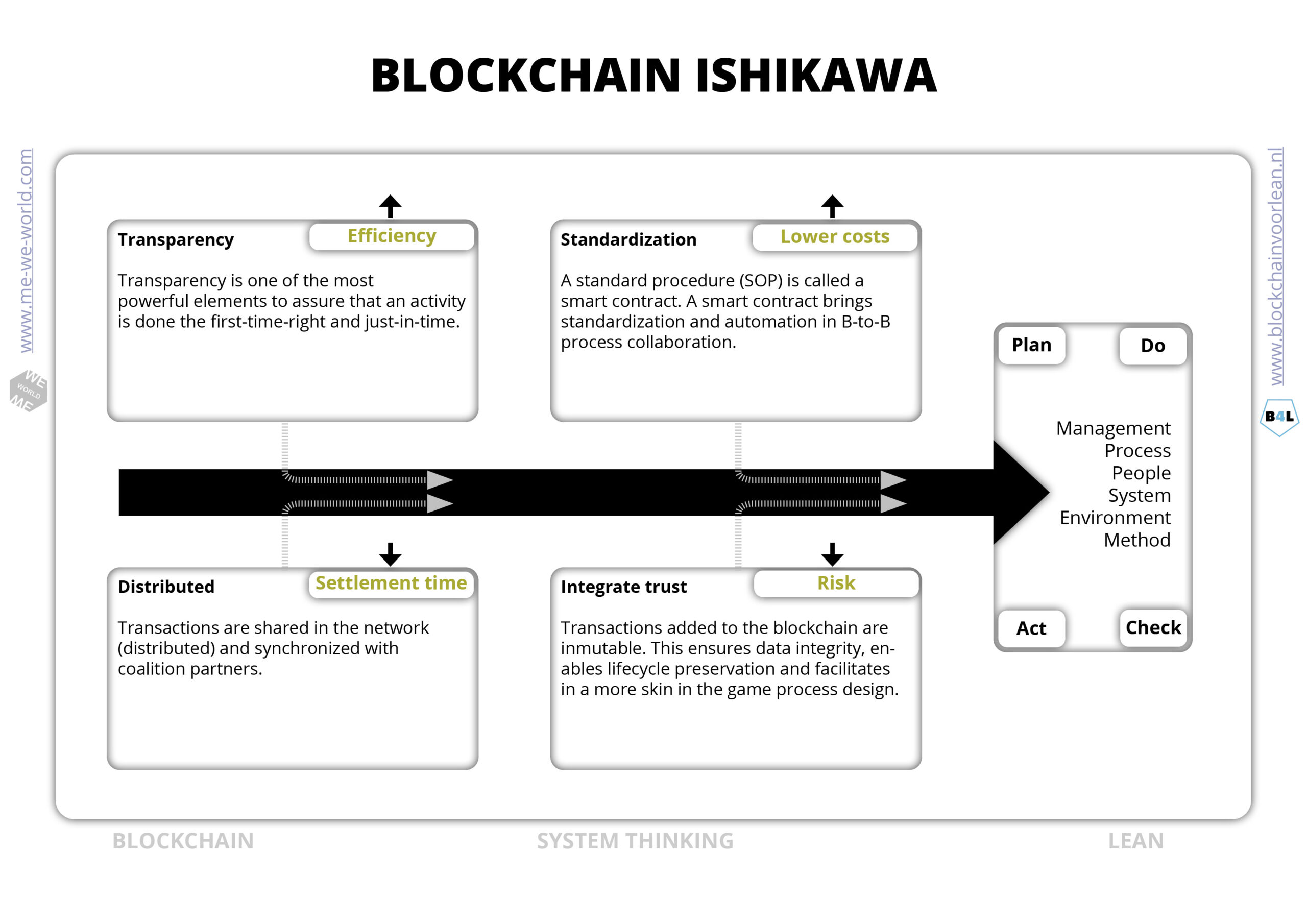
Blockchain success factors
With process optimization the focus has mainly been on lower costs, better quality, reliability, lead time and flexibility. In addition to those process optimization, we increasingly notice that other values are also become more and more important from a process optimization point of view. The dictionary of “enhancements” or “values” is slowly expanding. New “success factor metrics” includes: the reliability of the organization, the authenticity of products, origin, circularity, fair share, sustainability, etc.
